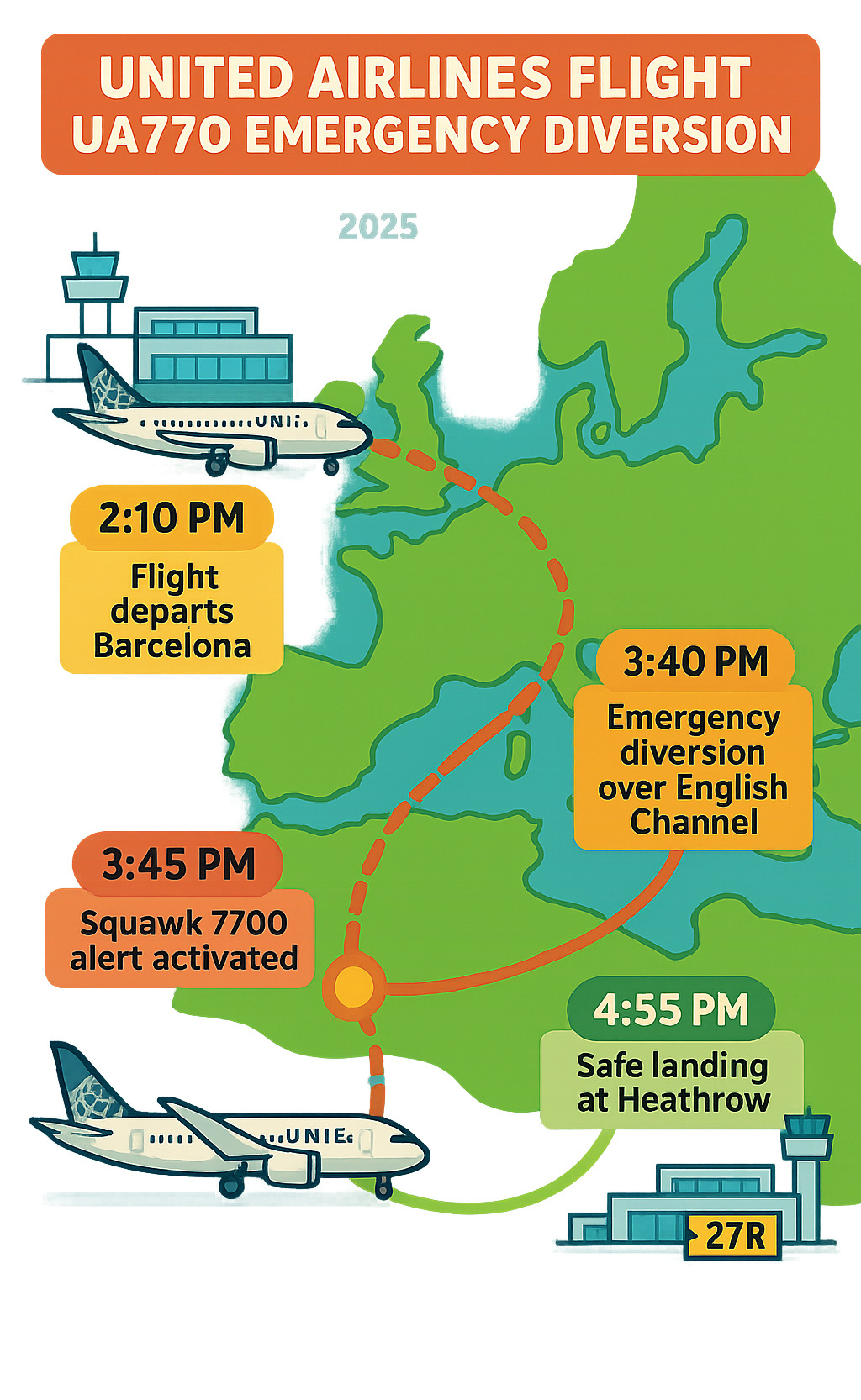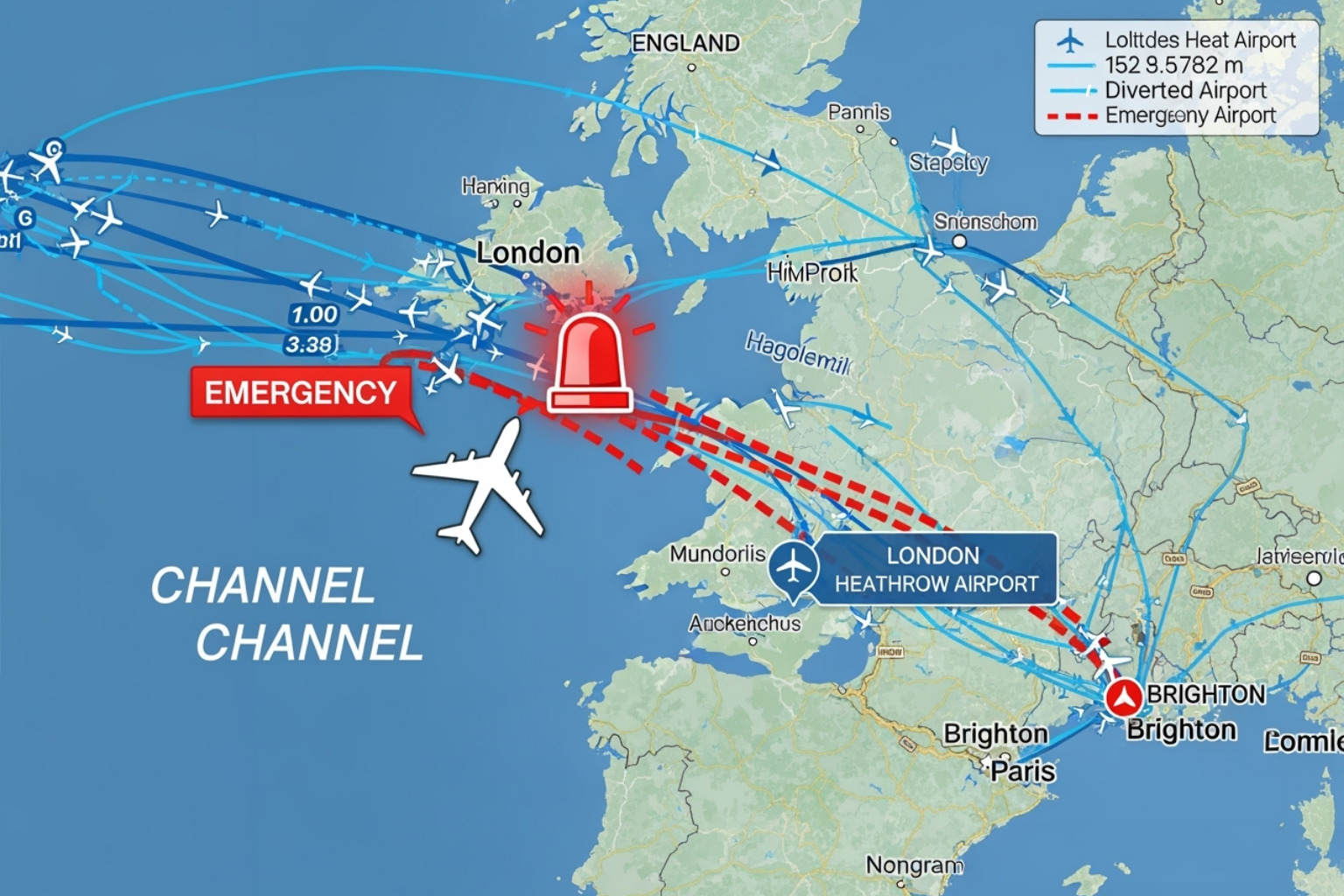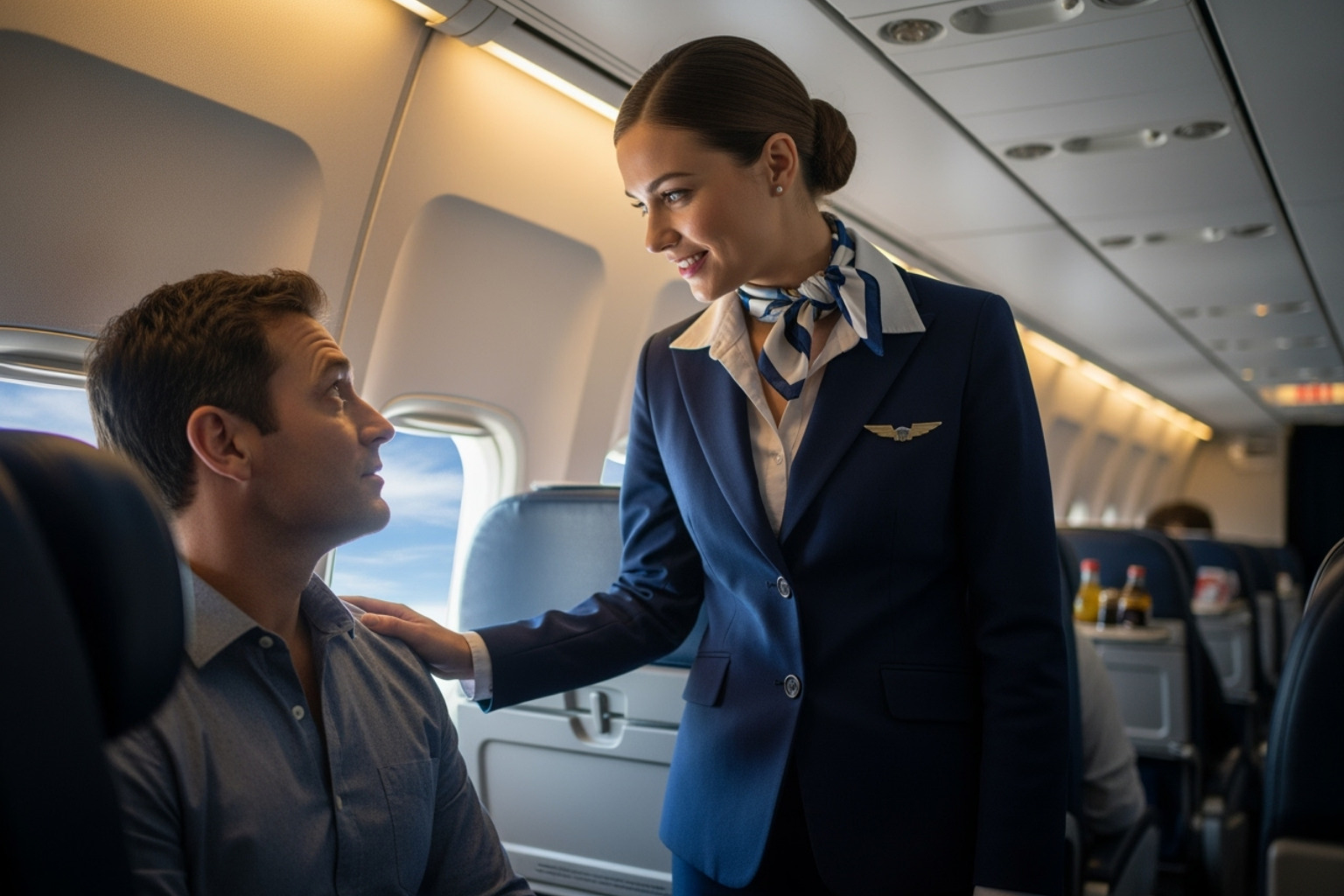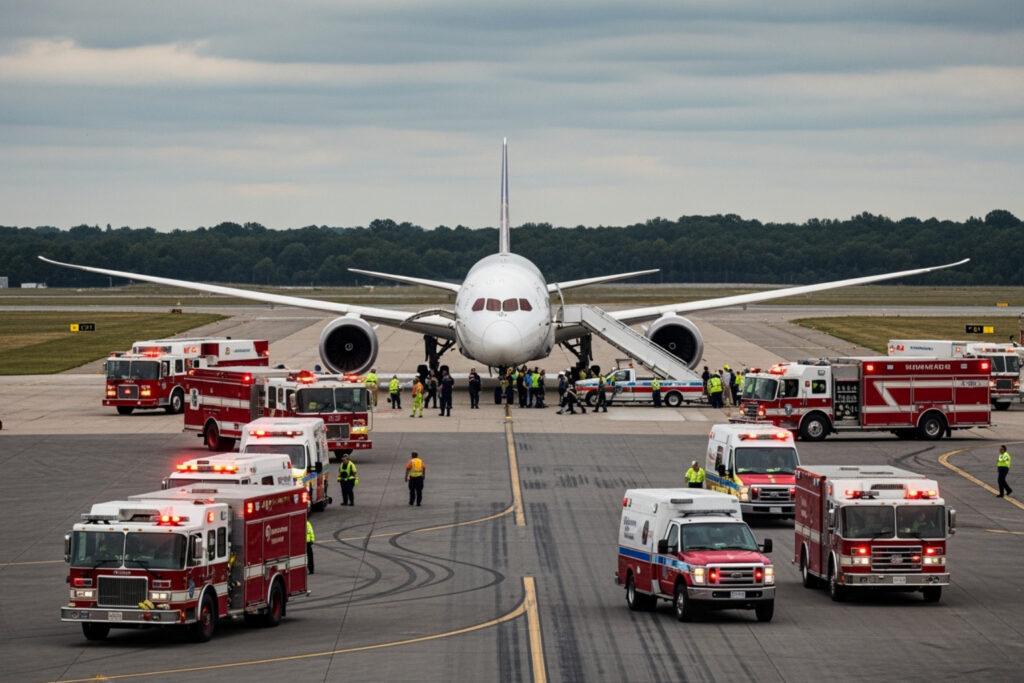Understanding the UA770 Emergency: What Travelers Need to Know
The United Airlines flight UA770 emergency diversion became a significant aviation incident when the Barcelona to Chicago flight was forced to make an unplanned landing at London Heathrow Airport. Here is what happened:
Key Facts About the UA770 Emergency:
- Aircraft: Boeing 787-9 Dreamliner (Registration N26902)
- Route: Barcelona (BCN) to Chicago O’Hare (ORD)
- Emergency Cause: Cabin pressurization anomaly
- Diversion Airport: London Heathrow (LHR)
- Landing Time: 4:55 PM BST on Runway 27R
- Emergency Code: Squawk 7700 (general emergency)
- Outcome: Safe landing with no injuries reported
The incident occurred approximately 90 minutes after takeoff when the crew detected a technical issue with the aircraft pressurization system. Following standard safety protocols, the pilots declared a general emergency and diverted to the nearest suitable airport.
Aviation emergencies like this highlight the importance of staying calm under pressure – a skill that extends far beyond air travel. Whether you are dealing with unexpected flight changes or the daily stressors of life, maintaining your wellness and composure becomes essential.
The professional response from the crew and their clear communication helped passengers manage their anxiety during this unexpected situation. As one passenger later noted, “the crew announcements helped keep panic at bay” through their composed and reassuring approach.

What Happened? The Full Story of the UA770 Diversion
On a seemingly routine flight, United Airlines Flight UA770, which departed from Barcelona, Spain, and was en route to Chicago, Illinois, found itself at the center of an unexpected emergency. This incident, the united airlines flight ua770 emergency diversion, serves as a powerful testament to the rigorous safety protocols and highly trained personnel that underpin modern air travel.
The journey began typically, but approximately 90 minutes into the flight, an unforeseen technical issue arose. The flight crew, trained for such contingencies, swiftly identified a cabin pressurization anomaly. This is a critical system failure that can impact passenger comfort and safety if not addressed immediately. In response, the crew made the decisive call to declare a general emergency, signaling their situation to air traffic control by “squawking 7700.” Squawking 7700 is an internationally recognized transponder code that alerts air traffic control to a general emergency, allowing them to prioritize the aircraft and clear airspace for its immediate needs.
The decision was made to divert to London Heathrow (LHR), one of the busiest and most well-equipped airports in the world, capable of handling such emergencies with extensive ground support and medical facilities. The aircraft, a Boeing 787-9 Dreamliner, executed a safe and controlled landing on Runway 27R around 4:55 PM BST. Crucially, there were no injuries reported among the passengers or crew, underscoring the success of the emergency procedures. This swift and efficient handling turned a potential crisis into a safely managed situation, showcasing the robust safety-first mindset of aviation.

The Critical Moment: Why the United Airlines Flight UA770 Emergency Diversion Was Necessary
The specific reason for the united airlines flight ua770 emergency diversion was a cabin pressurization anomaly. To put it simply, an aircraft cabin is pressurized to simulate a much lower altitude than the actual cruising height, typically around 6,000 to 8,000 feet. This ensures passengers and crew can breathe comfortably. When a “pressurization anomaly” occurs, it means there is a problem with maintaining this controlled environment. This could be due to a technical glitch, a seal issue, or a malfunction in the aircraft systems designed to regulate cabin pressure.
While the exact technical details of the glitch remain under investigation, the immediate declaration of a general emergency (Squawk 7700) from the crew signifies that they assessed the situation as serious enough to warrant an urgent and prioritized landing. This was not a minor inconvenience but a precautionary measure taken to uphold the paramount principle of aviation: safety first. The Boeing 787-9 Dreamliner, like all modern aircraft, is equipped with sophisticated monitoring systems that alert the crew to even subtle deviations from normal operating parameters. This early detection allowed the crew to act decisively, preventing the situation from escalating. It is a testament to the advanced engineering of these aircraft and the rigorous training of the flight crews that such incidents, though alarming, rarely result in serious harm.
Aircraft and Flight Path Details
United Airlines Flight UA770 originated from Barcelona Airport (BCN), a major international hub in Spain, with its intended destination being Chicago O’Hare International Airport (ORD) in the United States. The aircraft operating this flight was a Boeing 787-9 Dreamliner, a state-of-the-art wide-body aircraft favored for long-haul international routes due to its fuel efficiency and passenger comfort. Its specific registration number was N26902.
Upon the declaration of the emergency, the flight diverted to London Heathrow (LHR), one of the busiest and most capable airports in the world. Its extensive infrastructure, including multiple runways and emergency services, makes it an ideal choice for emergency diversions. The aircraft landed safely on Runway 27R, a standard landing strip at Heathrow, around 4:55 PM BST. The process of diverting and landing was executed flawlessly, demonstrating the seamless coordination between the flight crew and air traffic control. We can track more information about the history of the flight and its journey that day through flight tracking services. More info about the flight’s history
For those interested in the aircraft itself, its registration number N26902 provides a unique identifier within the global aviation fleet. This aircraft, a Boeing 787-9, is part of the modern long-haul fleet of United Airlines. Aircraft registration details
Professionalism at 36,000 Feet: Crew Response and Safety Protocols
When you are cruising at 36,000 feet and something goes wrong, there is no pulling over to the side of the road. The united airlines flight ua770 emergency diversion became a masterclass in how trained professionals handle high-pressure situations with grace and expertise.
The moment the pilots detected the cabin pressurization issue, their extensive training took over. Think of it like muscle memory – but with lives depending on every decision. They immediately declared Squawk 7700, the universal aviation code that tells Air Traffic Control: “We need help, and we need it now.” This simple action cleared their path through busy airspace and put emergency services on standby.
What happened next was like watching a well-choreographed dance. The pilots maintained constant communication with Air Traffic Control, working together to chart the safest route to London Heathrow. Meanwhile, the cabin crew shifted into their own emergency mode – but you would hardly know it from their calm demeanor.
Cabin crew communication during the incident was nothing short of remarkable. Instead of creating panic, the flight attendants became guides of reassurance. Their announcements were clear, honest, and delivered with the kind of steady voice that makes you think, “Okay, they have this handled.” One passenger later shared how the composure of the crew helped keep the anxiety of everyone in check – no small feat when you are dealing with an unexpected emergency.
The crew did not just talk the talk; they walked passengers through safety procedures without making it feel scary. They ensured everyone knew where the emergency exits were, checked that seatbelts were fastened, and prepared the cabin for what could have been an emergency landing. It is the kind of passenger reassurance that comes from knowing your job inside and out.
Behind the scenes, Air Traffic Control coordination was working overtime. Ground emergency services at Heathrow were alerted and positioned, ready to respond the moment the aircraft touched down. After the safe landing, thorough post-landing inspections began immediately – because in aviation, “good enough” simply is not good enough.

Standard Aviation Safety Protocols Followed During the Diversion
The united airlines flight ua770 emergency diversion followed a precise sequence of safety protocols that have been refined over decades of aviation experience. These are not just suggestions – they are the gold standard procedures that turn potential disasters into manageable situations.
- Declaring an emergency (Squawk 7700) – This universal distress signal immediately alerts air traffic control and grants the aircraft top priority over all other air traffic
- Communicating with Air Traffic Control for a new flight path – Continuous, clear dialogue ensures the aircraft gets guided to the nearest suitable airport with all necessary support
- Descending to a safe altitude – When pressurization fails, getting below 10,000 feet where the air is naturally breathable becomes critical for the safety of everyone
- Preparing the cabin for a potential emergency landing – The crew ensures passengers are secure, emergency exits are clear, and everyone knows what to expect
- Coordinating with ground emergency services – Fire, rescue, and medical teams are positioned and ready before the aircraft even touches down
These steps transform what could be chaos into a controlled, systematic response. It is why aviation remains incredibly safe, even when the unexpected happens. Just like maintaining your wellness routine during stressful times, having these protocols in place creates stability when everything else feels uncertain.
The Passenger Experience: Managing Stress and Uncertainty
Imagine settling into your seat for what should be a straightforward transatlantic flight, only to find yourself in the middle of an unexpected aviation emergency. For the passengers aboard the united airlines flight ua770 emergency diversion, this scenario became their reality, and it offers valuable lessons about managing stress when life throws you a curveball.
When the cabin crew first announced the pressurization issue, you can picture the immediate shift in atmosphere. Worried glances were exchanged across the aisles, conversations dropped to hushed whispers, and that familiar knot of anxiety began forming in stomachs throughout the cabin. Some passengers instinctively reached for their phones to text loved ones, while others gripped armrests a little tighter.
But here is where the magic of crew communication truly shone. Rather than leaving passengers to imagine worst-case scenarios, the flight attendants provided clear, calm updates throughout the diversion. One passenger later shared how “the announcements from the crew helped keep panic at bay” – a testament to how transparency can be the best medicine for anxiety.
The human response to uncertainty is fascinating. Some passengers found coping mechanisms in distracting themselves with books or movies, while others focused on deep breathing exercises. It is remarkable how people tap into their inner resilience when faced with unexpected challenges, something we can apply to stressful situations in our daily lives too.
When the wheels finally touched down safely at London Heathrow, the collective sigh of relief was almost audible. Many passengers broke into spontaneous applause – that universal way of saying “thank goodness we made it.” But as anyone who has experienced travel disruptions knows, landing safely is just the beginning of a new challenge: navigating the aftermath.
Navigating the Aftermath of the United Airlines Flight UA770 Emergency Diversion
Once the immediate crisis passed, passengers faced a different kind of stress – the logistical maze that follows any major flight disruption. The united airlines flight ua770 emergency diversion transformed a simple point-A-to-point-B journey into an unexpected London layover that nobody had planned for.
The response from United Airlines kicked into high gear the moment passengers stepped off the aircraft. Airline representatives were waiting with information about rebooking options, and the airline ground team worked to minimize the disruption. The reality of international travel means these situations can be complex, especially when you are talking about getting hundreds of passengers from London to Chicago on short notice.
For passengers who could not catch a same-day connection, the airline provided hotel accommodations and meal vouchers. While no amount of compensation can completely erase the stress of an emergency diversion, these practical supports help ease the immediate burden. Think of it as the way of the airline of saying, “We know this was not part of your plan, and we are here to help make it right.”
The communication channels remained open throughout the process, with regular updates about rebooking options and next steps. Passengers appreciated having clear information rather than being left to wonder what would happen next. It is a reminder that during stressful situations, whether it is a flight emergency or any life disruption, having reliable information and support makes all the difference.
What is truly inspiring about incidents like this is how they highlight our capacity for resilience. Just as we prioritize our physical wellness through skincare routines and healthy habits, nurturing our mental wellness helps us bounce back from unexpected challenges with greater ease and grace.
Frequently Asked Questions about the UA770 Diversion
When news of the united airlines flight ua770 emergency diversion broke, travelers and aviation enthusiasts alike had many questions about what exactly happened that day. Let us address the most common concerns with clear, straightforward answers.
What was the exact cause of the UA770 emergency diversion?
The diversion happened when the flight crew noticed something was not quite right with the cabin air pressure system. Think of it like this – when you are flying at 36,000 feet, the air outside is too thin to breathe comfortably. So aircraft have special systems that keep the cabin pressurized, making it feel more like you are at a much lower altitude.
During this flight, that system developed what is called a cabin pressurization anomaly. Essentially, the crew detected that something was off with how the aircraft was maintaining that comfortable, breathable environment inside the cabin. Rather than take any chances, they immediately declared a general emergency and headed to the nearest suitable airport.
This was not a case of panic or overreaction – it was exactly what their training taught them to do. When it comes to passenger safety, pilots always err on the side of caution. The quick thinking of the crew and their adherence to safety protocols turned what could have been a serious situation into a well-managed precautionary landing.
Were any passengers or crew members injured?
Absolutely not. This is perhaps the most reassuring part of the entire incident. The united airlines flight ua770 emergency diversion ended with everyone walking away completely unharmed.
The flight made a safe, controlled landing at London Heathrow Airport, and there were zero reports of injuries among passengers or crew members. This outcome speaks volumes about the professionalism of the flight crew, the effectiveness of modern aviation safety systems, and the robust emergency protocols that airlines follow.
From the moment the crew detected the issue to the final touchdown on Runway 27R, everything went according to plan. The passengers, while understandably anxious during the unexpected detour, were kept safe and informed throughout the entire process.
What type of aircraft was operating as Flight UA770?
The aircraft involved was a Boeing 787-9 Dreamliner – one of the most advanced passenger jets in the sky today. This particular plane carried the registration number N26902, which is like a unique fingerprint for aircraft.
The 787-9 is what aviation folks call a “wide-body” aircraft, meaning it is built for long international flights like the Barcelona to Chicago route UA770 was flying that day. These planes are packed with sophisticated monitoring systems that can detect even the smallest deviations from normal operations – which is exactly what happened during this incident.
What is particularly noteworthy is that the advanced systems of the aircraft worked exactly as designed. They alerted the crew to the pressurization issue early enough for them to take appropriate action. It is a perfect example of how modern aviation technology and human expertise work together to keep passengers safe, even when unexpected situations arise.
Just like how we prioritize wellness and safety in our daily routines, the aviation industry has built multiple layers of protection to ensure every flight ends safely – and this incident proves those systems work beautifully when they are needed most.
Conclusion: Lessons in Resilience and Prioritizing Wellness in Travel
The united airlines flight ua770 emergency diversion reminds us that life rarely goes according to plan – and that is okay. While the passengers aboard UA770 certainly did not expect their Barcelona-to-Chicago journey to include an unscheduled stop in London, their experience offers valuable lessons about resilience and grace under pressure.
What strikes me most about this incident is not just the technical precision of the crew or the sophisticated safety systems of modern aviation. It is the very human story of how people respond when faced with the unexpected. The passengers who remained calm, the crew members who maintained their composure, and the ground teams who swiftly coordinated support – they all demonstrated something we can learn from.
Travel disruptions test our resilience in ways we do not anticipate. Whether it is an emergency diversion, a canceled flight, or even a delayed train, these moments reveal how well we have prepared ourselves mentally and emotionally for life’s curveballs. The passengers on UA770 who praised the clear communication of the crew understood something important: staying informed and maintaining perspective can transform anxiety into manageable stress.
This connects beautifully to our broader wellness journey. Just as pilots train extensively for emergency situations, we can build our own toolkit for handling unexpected challenges. This might mean practicing deep breathing techniques, maintaining healthy routines even when traveling, or simply remembering that most disruptions are temporary inconveniences rather than true crises.
At Beyond Beauty Lab, we have always believed that true wellness starts from within – and that includes mental resilience. The same mindful approach you bring to your skincare routine can help you steer travel stress. Taking a moment to center yourself, staying hydrated, and maintaining small self-care rituals can make all the difference when your carefully planned itinerary goes sideways.
The safety-first protocol of the aviation industry offers another lesson worth embracing. Sometimes the best decision is the cautious one, even if it means short-term inconvenience. Whether we are talking about emergency diversions or choosing clean beauty products, prioritizing long-term wellbeing over immediate convenience often proves wise.
Learn more about enhancing your wellness journey and find how small, consistent practices can build the resilience that serves you whether you are dealing with flight delays or daily stressors. After all, the most beautiful thing about the UA770 story is not the technical systems that kept everyone safe – it is the human capacity to stay calm, support each other, and find grace even at 36,000 feet.








